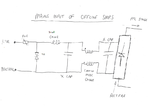T
treez
Guest

The Cu-Beam light is certainly the best LED light that the worldwide market has to offer, however, the spec says that the LED lasts 180,000 hours (20 years) and that the offline LED driver that ships with it lasts as long as the LED (ie, 20 years).
The Offline LED driver is said to last the 20 years because of having big heatsinks and special capacitors.
..Surely no offline LED driver can last 20 years?
I mean, in 20 years, it is likely to succumb to mains transients which will result in the MOV failing short and thereby blowing the input fuse...this happening well before 20 years?
If mains transients are not such a problem, then why does Littelfuse sell these LED lighting mains surge protectors?…
Littelfuse LED lighting surge protectors:-
https://www.littelfuse.com/~/media/...ghting_surge_protection_modules_flyer.pdf.pdf
Cu-Beam suspended LED light:-
https://www.dyson.co.uk/lighting/cu-beam-suspended-lights.aspx
Spec of Cu-Beam LED light:-
**broken link removed**
The Offline LED driver is said to last the 20 years because of having big heatsinks and special capacitors.
..Surely no offline LED driver can last 20 years?
I mean, in 20 years, it is likely to succumb to mains transients which will result in the MOV failing short and thereby blowing the input fuse...this happening well before 20 years?
If mains transients are not such a problem, then why does Littelfuse sell these LED lighting mains surge protectors?…
Littelfuse LED lighting surge protectors:-
https://www.littelfuse.com/~/media/...ghting_surge_protection_modules_flyer.pdf.pdf
Cu-Beam suspended LED light:-
https://www.dyson.co.uk/lighting/cu-beam-suspended-lights.aspx
Spec of Cu-Beam LED light:-
**broken link removed**






